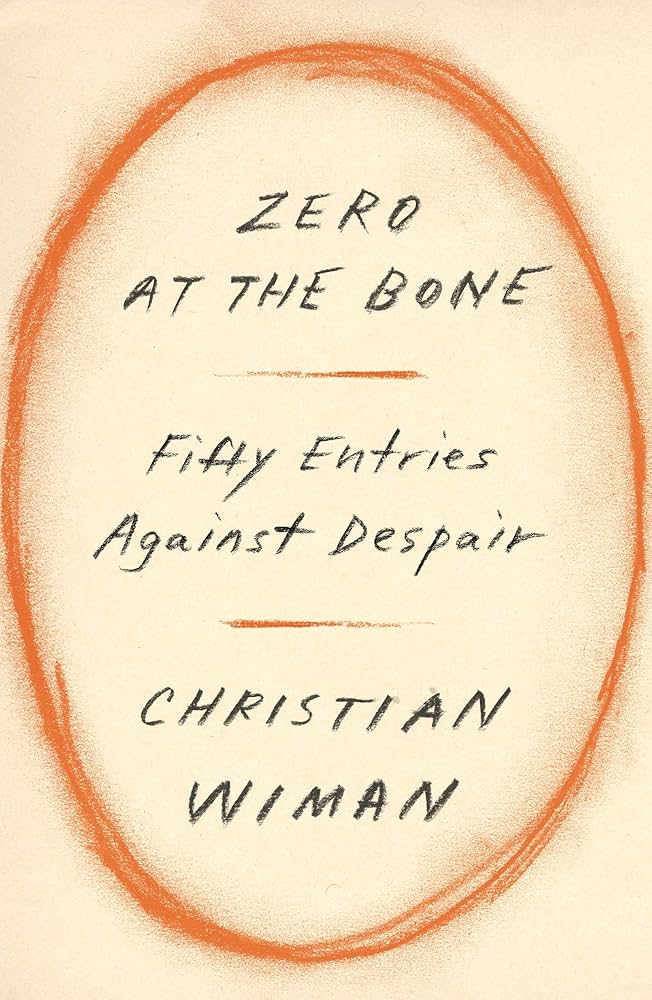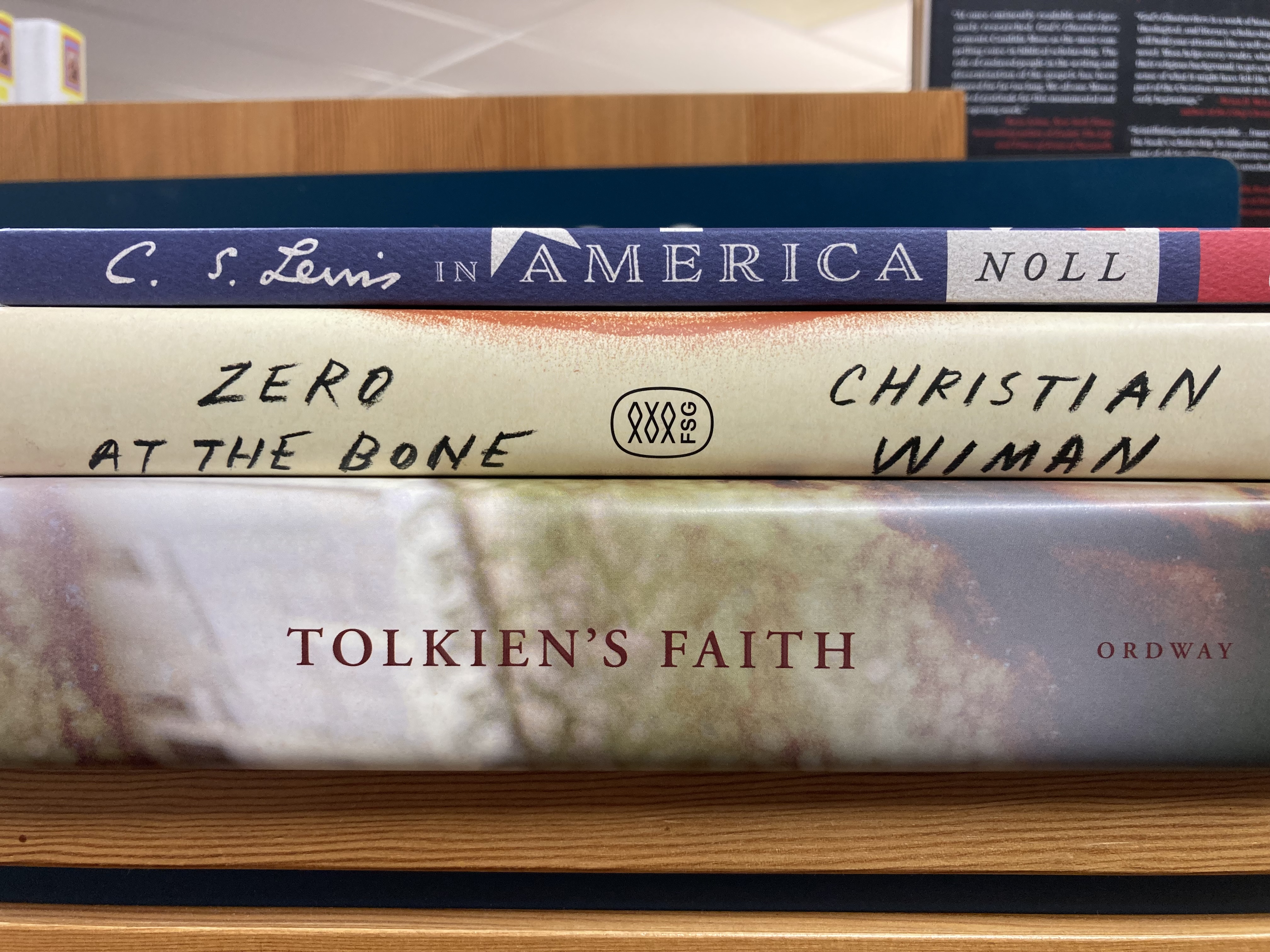Bill on Books
Summer 2024
Bill reviews a poet's manifesto against despair, a spiritual biography of a beloved Inkling, and Mark Noll's study of C.S. Lewis' early American reception.

Zero at the Bone: Fifty Entries Against Despair
Farrar, Straus and Giroux,
2023
A ripsaw of a read and not for the faint of heart. The title, taken from an Emily
Dickinson poem, suggests a dead zone, accompanied by fear, dread and, importantly
for the author, awe, and experience of God. Wiman, who has “an intimate
acquaintance with the condition of despair,” takes us on a deep journey via poetry,
prose, literary and theological reflection, and even a sermon. Along the way one
finds out that the author has been living so long with cancer and endless rounds of
chemo that it “bores him": “the hard blast of chemo in the fall” and the “four rounds
of pneumonias that followed.” Wiman was deeply scarred by growing up in a family
where he saw more violence than a child can bear. It is his marriage and the birth of
two girls, after a stillborn son (“hot from the womb but cold to kiss”), that bring
healing and joy to Wiman who describes the gift of one’s child as jolting “loose a
sadness.” I appreciated the poetry sprinkled throughout the text and especially the
use of George Herbert. No doubt Wiman’s use of Herbert was because the poet
himself was dying of tuberculosis while writing his timeless words. Doubt and an
“apophatic” God (he is only known in terms of what he is not) are common themes
but Wiman admits that “when doubt becomes the path of least resistance it
becomes the very thing that a faithful person must most resist.” This is a beautiful
book that brings a “jolt of hope” and with it a sense that Christ gazes through the
deepest darkness. Trinity Forum has recently posted an interview with Wiman
on Zero at the Bone: https://www.ttf.org/portfolios/episode-89-words-against-despair-with-christian-wiman/
Available for in-store purchase only.

Tolkien’s Faith: A Spiritual Biography
Word on Fire Academic
2023
Why does Tolkien still matter and why a review on yet another book on the Inklings,
that literary circle that included J.R.R. Tolkien and C.S. Lewis? Simply put, Tolkien’s
Lord of the Rings has sold 150 million copies and The Hobbit 100 million putting both
in the top ten best selling books of all time. That Tolkien was a committed Christian
makes him significant for the Church and its history. At the beginning of her book,
Holly Ordway cites a Tolkien quote that serves as her thesis: “The Lord of the Rings
is, of course, a fundamentally religious and Catholic work; unconsciously so at first,
but consciously in the revision.” For Tolkien, orphaned at an early age, it was a
Catholic priest in Birmingham, Father Francis Morgan, who shaped his early life and
set it in a Christian direction. As a newly married man and a student at Oxford,
Tolkien’s life was interrupted by World War I and the Battle of the Somme. His
experience of trauma in the trenches profoundly shaped his writing, even if
unacknowledged by the writer. Most of his friends died in battle. One such friend, in
a last letter, urged Tolkien: “Yes, publish! You I am sure are chosen, like Saul among
the children of Israel…” Unlike Saul, Tolkien remained a humble man and was not
overcome by fame but was sustained by faith. Ordway points out Tolkien’s respect
for the mystery of life, his disposition to mercy, and that his life was consciously lived
within the “communion of the saints.” Several days a week he attended morning
prayer and the Eucharist, was especially appreciative of prayers of praise to God, and
“he exercised forgiveness,” even when this was difficult as he could be “contrarian
and pedantic” and even “volcanic.” He remained faithful to his wife Edith and was a
loyal and present father, even if flawed. At times Tolkien the person is obscured by
extended passages on Catholic doctrine and practice but Ordway usually succeeds in
circling back to show how these Christian beliefs shaped his writing. The book was a
labour of love, which saw Ordway travel extensively on both sides of the Atlantic,
hunting down all things Tolkien. We are in her debt.
Available for in-store purchase only.

C.S. Lewis in America: Readings and Reception, 1935-1947
InterVarsity Press
2023
Between 1935 and 1947, the Oxford scholar C.S. Lewis published a number of literary
works plus several works of imaginative writing and Christian exposition that
included his Broadcast Talks (which were published together in 1952 as Mere
Christianity), The Abolition of Man, The Great Divorce, Screwtape Letters and the
Ransom Trilogy. In Chapter One, historian Mark Noll documents that the earliest
responses to Lewis, starting in 1935, were generally from Roman Catholic authors
writing in Church journals, who were, overall, quite positive with only occasional
doctrinal quibbles. Mainstream Protestant notice began in earnest with the
publication of Screwtape Letters in 1943 and was almost uniformly positive, albeit
with The Christian Century exhibiting a “patronizing” attitude to Lewis. Evangelicals
were the last and most cautious in their response to the writings of Lewis. Positive
early reviewers, both Catholic and Protestant, included Thomas Merton, Bishop
Fulton Sheen, W.H. Auden and literary scholar Chad Walsh who wrote the first book
on Lewis and his writing. Noll points out that none of these early reviews were
“earthshaking” but, in sharp contrast with today, do demonstrate that in the 1940s
the “gatekeepers” of American public opinion could still positively respond to skilful
writing even if it possessed Christian themes. The publication of Screwtape Letters in
1943 did capture a slice of the public imagination as seen in the Time cover story on
Lewis in 1947. What made Lewis so unique and incapable of replication? J.I. Packer
thought that the “secret” of his “great piercing power” resided in Lewis’s “blend of
logic and imagination.” What lessons can we learn from Lewis for today? Noll
acknowledges the vast cultural shifts that have taken place since Lewis’s time but
believes that still we have much to learn from both the “savvy” and “unassuming”
way in which Lewis approached his craft. Noll points out that Lewis was most
concerned about the soul of the writer rather than the success of the writing.
Available for in-store purchase only.



